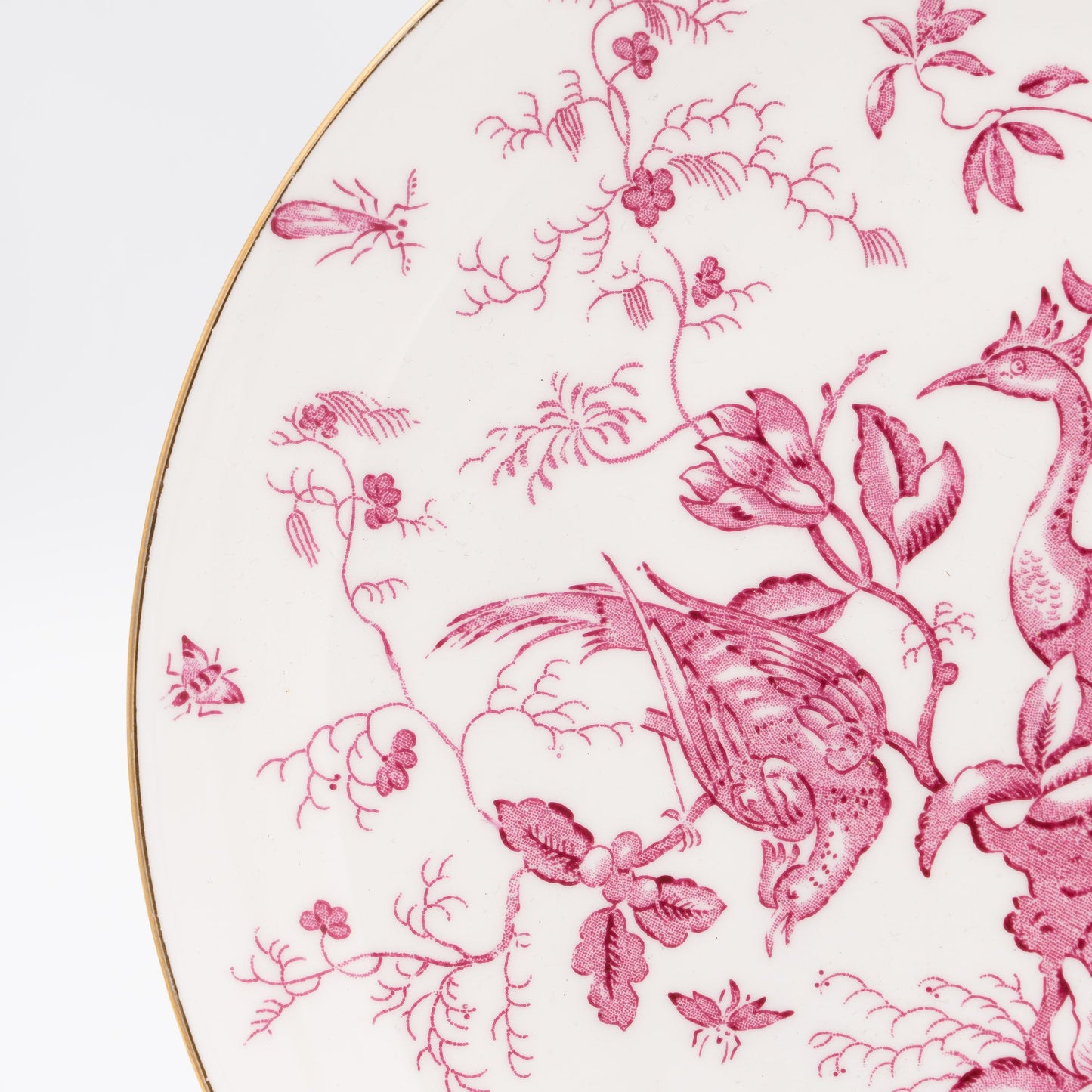Coalport
Coalport “Cairo” Plate – Pink Transferware with Gilt Rim – c. 1930–1950
Coalport “Cairo” Plate – Pink Transferware with Gilt Rim – c. 1930–1950
Couldn't load pickup availability
A luminous Coalport “Cairo” plate in rich cerise-pink transferware, dancing with exotic birds, butterflies and trailing blossoms. Elegant bone-china finesse, finished with a fine gilt rim.
Coalport’s “Cairo” pattern captures the late-Aesthetic taste for the exotic: long-tailed birds poised amongst fantastical blooms, butterflies, and delicate tendrils, all rendered in a crisp raspberry-pink transfer. On bone-white china the colour sings, while the slender gilt line lifts the composition with a whisper of luxury.
This example carries the Substandard backstamp used by Coalport for pieces with a tiny glaze or print irregularity (often only detectable on very close inspection) and was retailed alongside firsts in the mid-20th century. An exquisite accent for a pink-and-white tablescape, a stand-alone wall plate, or the perfect addition to a growing transferware collection.
- Material: Bone china (porcelain)
- Maker: Coalport
- Motif: Exotic birds, butterflies and flowering branches (“Cairo” pattern), pink transfer with gilt rim
- Style: Aesthetic / Chinoiserie revival, transfer-printed
- Place of Origin: England
- Mark: Printed Coalport backstamp “BONE CHINA – MADE IN ENGLAND – ADIT?O – ‘CAIRO’ ” with SUBSTANDARD (see photos)
- Date of Manufacture: c. 1930–1950
- Condition: Very good vintage condition. Bright glaze and colour; light utensil marks and minor age-related wear to the gilding as expected. No cracks or hairlines observed. Please see all photos for the best description.
Share
- Worldwide Shipping
- Secure Packaging
- Loving Curation







Origin & Maker
Coalport began under John Rose in the late 18th century at Coalbrookdale, Shropshire, and by the 1790s was producing some of the most admired English porcelains of the day. The factory soon relocated to the nearby village of Coalport—hence the name—and earned a reputation for fine bone-china bodies with a clear, luminous glaze. Early wares often echoed fashionable rococo and neo-classical tastes, while the 19th century brought richly enamelled services and intricate gilding that appealed to an international clientele.
From the Victorian era through the early 20th century, Coalport embraced transfer printing alongside hand enamelling, creating patterns that blended English florals with Aesthetic and Chinoiserie influences. (Collectors will recognise long-lived designs and later revivals carrying the familiar “COALPORT – AD 1750” backstamp.) In 1926 production moved to Stoke-on-Trent, and by the mid-century the firm’s refined table and tea wares were exported widely; some pieces were marked “Substandard” for tiny kiln or print irregularities, a common practice that kept quality high without waste.
Acquired by Wedgwood in 1967, Coalport’s legacy continues to be celebrated for its elegant shapes, crisp transfers, and tasteful use of gilding. Whether you’re building a service or displaying a single showpiece, Coalport remains a benchmark of English bone-china craftsmanship.
Blog posts
View all-

A Serendipitous Morning at the Rue de Bretagne ...
There are few joys in life that match the thrill of stumbling upon a hidden treasure, and for me, flea markets hold that magical allure. One of my favourite flea...
A Serendipitous Morning at the Rue de Bretagne ...
There are few joys in life that match the thrill of stumbling upon a hidden treasure, and for me, flea markets hold that magical allure. One of my favourite flea...
-

Emile Bourgeois and "Le Grand Dépôt" in Paris
Recently, I found this stunning Sarreguemines wash set. It was at the Brocante in Belfort, France. On this day, we had got up at 4 AM to be there in...
Emile Bourgeois and "Le Grand Dépôt" in Paris
Recently, I found this stunning Sarreguemines wash set. It was at the Brocante in Belfort, France. On this day, we had got up at 4 AM to be there in...
-

The Legacy of Robert Haviland: A Journey from N...
The story of Robert Haviland porcelain is one of artistry, transatlantic ambition, and enduring heritage. It begins in the mid-19th century when David Haviland, an enterprising New Yorker, founded Haviland...
The Legacy of Robert Haviland: A Journey from N...
The story of Robert Haviland porcelain is one of artistry, transatlantic ambition, and enduring heritage. It begins in the mid-19th century when David Haviland, an enterprising New Yorker, founded Haviland...










